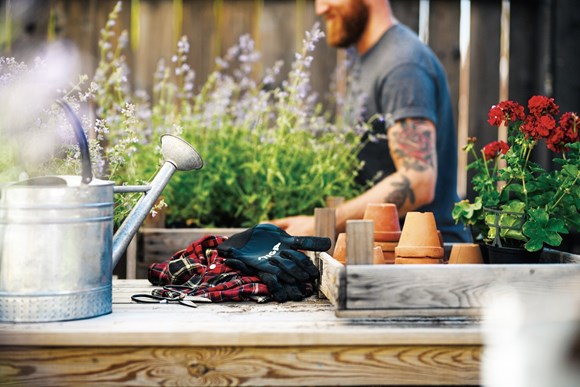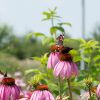Taking Care of Gardens in Late Summer: A Healthy and Flourishing Garden in 5 Steps.
To promote the preservation of nature, it is essential to keep in mind that every garden consists of an ecosystem of elements – plants, animals, micro-organisms – and that lawn care is not limited to mere grass cutting; it is necessary to have a holistic approach to garden care, paying equal attention to all the elements that “make it alive.” This is precisely the message that STIGA, Europe’s leading manufacturer and distributor of garden equipment, aims to communicate with its #MyPatchOfGreen project: every garden, no matter how large or small it is, represents a precious, rare resource in the world and should therefore be preserved and protected.
Optimal Garden care requires a series of ad hoc practices, tailored to each green space. Fabio Banin, STIGA Expert and agronomist, shares 5 simple tips for a healthy summer garden:
Efficient and Sustainable Irrigation
Most of our lawns will actually be lush and green now due to the wet and cooler weather we have been experiencing recently. However if we do hit a dry spell again and unless you are experiencing a hosepipe ban at the moment, you should not be watering at all. Early morning is the ideal time for watering the lawn. For efficient and sustainable irrigation, the timing of the irrigation system must be adjusted so that all areas of the land receive the necessary water supply by sunrise. This has a double advantage: water saving on the one hand, and a healthier lawn on the other.
In particular, in the early morning wind is less likely to blow, which would otherwise evaporate part of the water, impeding it from reaching the ground. Moreover, morning irrigation reduces the time span for which the grass remains wet, thanks to subsequent exposure to sunlight; especially in the summertime, it is important that the garden dries out as quickly as possible from irrigation in order to prevent the proliferation of pathogenic fungi and pests, and to keep your green space healthy.
Grass Mowing: Avoid the hottest hours and stick to the 1/3 rule
To maintain a lush and green garden, it is crucial to avoid lawn mowing during the hottest hours of the day. This is because, during this time of the day, plant tissues are deprived of water, a condition which can strain the mower, severely worsening the quality of the cut and thus precluding proper regrowth.
Mowing frequency is also important for lawn health. The ideal frequency is determined based on the growth speed of the individual lawn and the desired height of the lawn. As STIGA Expert Fabio Banin explains, the basic rule is that one should never trim more than 1/3 of the length of the grass blade. When the cut plant matter exceeds this limit, it means that the mowing frequency is too low; as a result, the stress suffered by the plant can become problematic, making it necessary to increase the number of cuts. When faced with this situation, it is recommended to raise the mower blade and cut at the maximum height allowed by the machine, then make a first cut at a higher height than desired. After a few days, it will be possible to carry out a second cut at the desired height.
Garden care is also synonymous with the protection of biodiversity
In order to protect biodiversity, a holistic approach to garden care also means paying attention to the little animals that populate the garden, such as bees and hedgehogs, creating a friendly environment for their life and so maintaining the balance of the ecosystem as a whole. To this end, the STIGA expert’s recommendations are:
- Avoid night mowing with the robot mower. Many animals move or feed at night time.
- Keep the grass taller in some areas of the garden, such as under trees. This creates refuges for animals or insects.
- Encourage diversity. Use a variety of flower and plant species in your garden, preferring native ones and those that produce flowers and berries, to encourage the presence of pollinating insects, birds and other animals.
- Limit the use of chemicals. Chemical pesticides, especially during the blossoming season, are harmful to insects in the lawn. Where their use is needed, carefully follow the safety instructions on the label and, if possible, seek professional advice.
Holidays are not an obstacle
In view of the summer holidays, one often wonders what to do to protect and keep their green space healthy during a period away from home. While it is useful to have a trusted person mow the lawn while absent to maintain the usual cutting height, an alternative is to use a robot mower, such as STIGA’s Robots. This will prevent the grass from overgrowing, thereby avoiding the possible shock it would suffer with a drastic cut on our return – as the 1/3 rule dictates. It is also crucial to remember to remove any weeds from the edges of the lawn, thus preventing them from further expanding in our absence and becoming unmanageable once returned home.
Getting ready for autumn
In the run-up to autumn, simply observe two basic rules of garden care: maintain the ideal cutting height for your lawn and avoid leaving the lawn covered with fallen tree foliage for a long time. To this end, incorporating leaves into the soil using a mulching mower, which will shred them into useful organic matter for the lawn, is both a smart and sustainable solution for a healthy garden. Alternatively, it is recommended to intervene by removing the leaves with a blower or vacuum fan.
Poppy Watt


